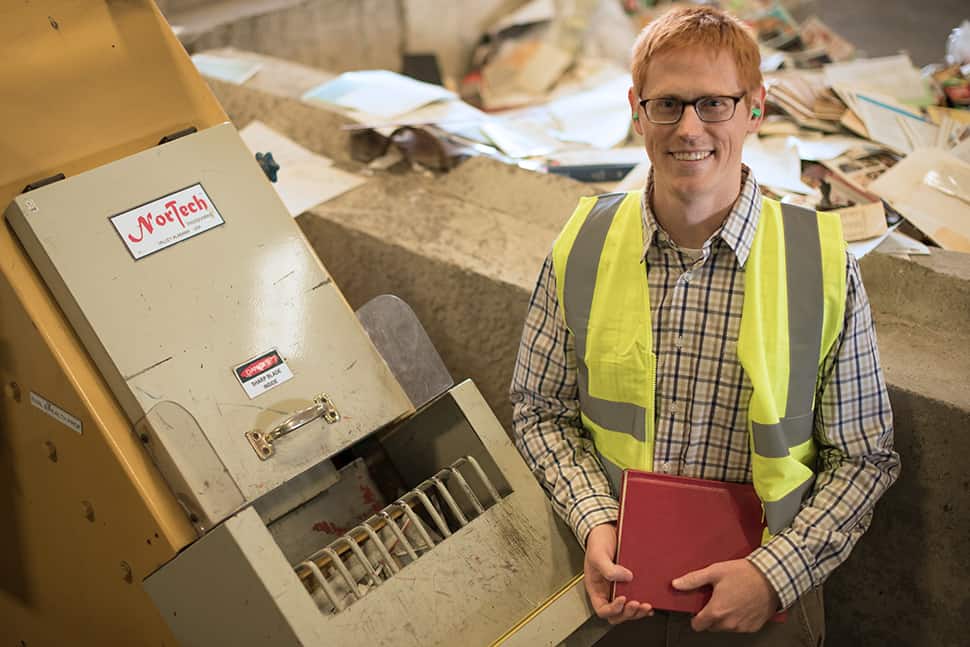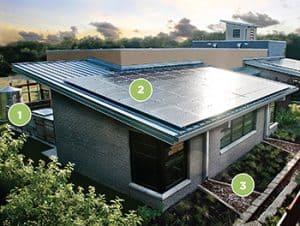
Many librarians don’t frequently worry about insects and rodents on the job. But when Michigan State University (MSU) librarian Eric Tans was approached by another department about starting a composting program, he fought to convince his administration that composting wouldn’t attract pests that would threaten library materials.
“When you start talking about compost and food waste, people immediately think of fruit flies and mice and stinky garbage,” Tans says. As the school’s environmental sciences librarian, Tans participates in MSU Libraries’ robust programming around recycling, composting, and deaccessioning books.
Founded in 1855, MSU is a historically agricultural school. The institution’s long tradition of interest in plants, forestry, and farming is reflected in the library, which has been recycling for more than 30 years. The university has diverted tons of waste and earned more than $100,000 from its efforts.
Tans and colleagues at MSU join librarians and libraries across the nation whose innovative green infrastructure and architecture are on the cutting edge of eco-consciousness—and whose success can be measured in pounds, kilowatts, and dollars. From carbon emission reduction to rainwater harvesting to smart solar to electric vehicle charging, some of the most creative sustainability efforts have been taking place at US libraries.
A unique model
In the early 1980s, MSU library staff started a recycling program, and by 1990, the university approved an interdisciplinary board dedicated to sustainability issues called the Library Environmental Committee (LEC).
“I imagine that getting the LEC started at a time that no other environmental units existed on campus was quite a challenge,” Tans says.
Nowadays, LEC supports an impressive array of eco-initiatives, including diversion—the rate at which material is removed from the waste stream through recycling, composting, or reuse. MSU Libraries surpassed a campuswide goal for a 70% diversion rate by 2017. By comparison, nationwide, less than 35% of municipal solid waste is recycled or composted, according to a 2016 Environmental Protection Agency report.
Still, library staffers push themselves to improve. In 2016, during a two-month intensive waste-reduction campaign called Zero Waste Mania, the library’s diversion rate reached 84%. It achieved this simply by improving its signage, adjusting the placement of its bins, and heavily promoting reuse and recycling. In some cases, diversion has inspired one-of-a-kind reuse: for instance, flower planters made from old bunk beds.
The MSU library offers a model for another sustainability measure: deaccessioning books. Not much literature exists around what happens to books once libraries weed them. MSU Libraries launched its own data analysis, and partnered with the MSU Surplus Store—a shop where the public can buy things like dorm furniture and books that might otherwise be sent to a landfill—to either reuse or recycle 100% of the material withdrawn from the library collection or collected from public donation bins. The Surplus Store staff sells or debinds and recycles the texts. Through online and onsite sales, the Surplus Store has sold about $150,000 worth of books, and have debound and recycled about 90 tons of materials.
Smart uses of sun and rain

In Austin, Texas, like many parts of America, water must be carefully managed. That’s why the Twin Oaks branch of Austin Public Library collaborated with the city’s Watershed Protection Department on a high-tech rainwater catchment and irrigation system. The library already xeriscaped—or landscaped in a manner that requires little or no water—but a computerized rainwater system allows the library to make best use of every raindrop and prevent pollution from stormwater runoff. Cisterns collect rainwater and HVAC condensate. In advance of storms, satellite weather forecasting triggers the system to automatically draw down tanks. And a biofiltration pond cleans the water before it enters the city’s stormwater systems.
In Berkeley, California, residents voted in 2006 to push forward an ambitious goal: By 2050, reduce the community’s greenhouse gas emissions by 80% below 2000 levels. Berkeley Public Library’s West branch has been leading the way since it opened in 2014. One of the few “net zero energy” municipal buildings in the US, each year it has produced more power than it uses, thanks to solar panels, radiant heating and cooling, windows and skylights, a wind chamber, and large ceiling fans. Some of that surplus goes to electric vehicle charging stations in the library parking lot, which were installed in partnership with the city’s Office of Energy and Sustainable Development. The library uses income from the charging stations to offset operating expenses.
Tight budgets inspire innovation
Many other libraries like Berkeley’s have been learning that going green, in fact, saves green. Take Mason City, in north-central Iowa, with a population of about 28,000. Five years ago, the city council told its public library that it faced a choice: Cut staff, cut hours, or cut costs.
“No self-respecting town would forgo their library,” says Mary Markwalter, director of Mason City Public Library. She and Barbara MacGregor, president of the library’s foundation, decided to get creative.
MacGregor attended a workshop about solar power at a local community college. She learned that not only could the technology help reduce operating expenses but that grants were available to offset the cost of installation. She delivered this knowledge to the rest of the foundation board, and her enthusiasm spread.
But there was a hiccup. To access public funds for the project, their idea needed to reach the request for proposal phase, which required analysis, design, and engineering plans—at a cost of $27,000. They needed this research to make the case: Could the roof support the weight of the solar panels? Was the building positioned to receive enough natural light to power the project? Would the building’s 2008 electrical upgrades be compatible with solar panels?
“We needed some backup information to make it real,” MacGregor says. When she presented the request to the board, the library’s foundation voted immediately to fund the analysis.
Solar panels were deemed feasible, and Markwalter met with 17 potential solar providers. In the end, her team narrowed it down to three candidates. Still, the city council rejected the plan—twice. The council wanted to recoup its investment of $170,000 in upfront costs within a decade, but no provider could reach that timeframe. The closest proposal was 13.5 years.
Then, according to Markwalter, one of the vendors told her he would figure out how to make it work without the city council’s money. “One way or another, there will be a solar panel on that roof next year,” he insisted.
Jason Hall of MoxieSolar, the vendor, found private investor Sun Powered Solutions based in Cedar Falls. The company was interested in alternative energies and agreed to pay for the panels and entered a power purchase agreement with the library. In exchange, it was eligible for large rebates that the library itself didn’t qualify for. The rebates repaid much of Sun Powered’s initial investment within 18 months after the plant became operational. The library pays the company every month as it would a utility company, and after 15 years, the library will own the solar plant and all the electricity it produces.
The panels were installed in 2016 and, in the year since, the Mason City Public Library has saved $26,000 on gas and electricity, a 38% reduction from its 2008 spending. The panels were projected to save $167,000 over a decade, but they’re on target to save even more—$260,000 over 10 years.
“Libraries should inspire—from the minute you drive up to when you leave,” says Markwalter.
“Every day we can track how many kilowatts have been saved thanks to our solar roof,” MacGregor says. “How many trees would have been planted to equal that impact. How much fossil fuel we’ve avoided. It’s inspiring.”

 LIZ GRANGER is a Chicago-based nonfiction writer. Find her work at
LIZ GRANGER is a Chicago-based nonfiction writer. Find her work at 
